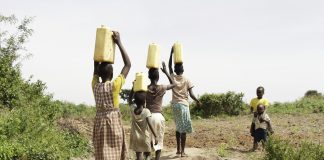In times when the land is parched, we see crops wither in the sun, commodity prices skyrocket, and local economies destabilize. For these reasons, researchers have long suspected a direct link between drought conditions and human conflict in developing regions such as sub-Saharan Africa.
Now one study published in the Journal of Environmental Economics and Management has become the first to link drought to the increased chance of violence using empirical data. And it even quantifies the additional impact of geographic and social factors in this link. The findings highlight just how important stable political structures and forward-thinking policies will be as we look to a future in which climate change increases the frequency and severity of droughts around the world.
To best illustrate the growing international concern over drought-driven conflict, the study looked to president of the Pacific Institute Peter Gleick. Gleick believed “the risk of conflicts over water is growing — not shrinking — because of increased competition, because of bad management and, ultimately, because of the impacts of climate change. […] The biggest worry today is sub-national conflicts: conflicts between farmers and cities, between ethnic groups, between pastoralists and farmers in Africa, between upstream users and downstream users on the same river.”
For the study, researchers focused on 43 countries in sub-Saharan Africa with a minimum of one million inhabitants. Beginning from 1999 through 2011, they compared drought calculations against data collected on localized riots.
But study author Jérémy Lucchetti took care not to consider drought as the main cause of a given riot. “In order of importance, it is political, economic and social causes that create tension,” he said in a statement. “Droughts are a factor that add fuel to flames that are already burning.”
Still, the study found a clear link between the two factors. Across any type of terrain, lack of water led to a 10% increase in the risk of rioting. And certain other factors brought the risk up even further to 50%:
- Greater population density led to greater risk of riot as more people fought for the same amount of limited water resources
- A lack of lakes and rivers multiplied the risk of conflict by two whereas places with these natural bodies of water saw the risk decrease proportionally.
- If several different ethnic groups have to share, traditional institutional arrangements can collapse in the face of water shortage.
More than other regions of the world, sub-Saharan Africa is particularly vulnerable to bursts of conflict from water shock because as much as 95% of crops are rain-fed while only 5% of all cultivated land is suitable for irrigation. And according to the UN World Water Development Report, 340 million people lack access to clean drinking water.
The paper ends with questions to explore for further research. Specifically, we all know rioting can – though not necessarily – lead to larger conflicts in a state. They can escalate to the point of rebellion and revolution which in turn can cause international instability.
“We now have to use this data to examine in detail what mechanisms could be put in place by political institutions to avoid riots, such as setting up redistribution systems in areas affected by drought,” Lucchetti said.











